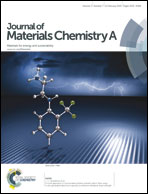Synthesis of hierarchical porous N-doped sandwich-type carbon composites as high-performance supercapacitor electrodes†
Abstract
Sandwich-type graphene based N-doped carbon materials (RGO@HTC) were prepared by the in situ carbonization of glucose molecules on the surface of graphene oxide sheets in the presence of ethylenediamine (EDA), followed by KOH activation to further enhance the porosity. The results revealed that hydrothermal carbon layers uniformly coated both sides of the graphene sheets, achieving sandwich-type composites with a hierarchical porous structure. The introduction of EDA with two amino terminals not only ensured the nitrogen doping into carbon composites, but also induced the hydrothermal carbonization of glucose to take place on the surface of GO as a binder. The influence of the reactant ratio, activation reagent amount, activation temperature on morphology, structure and electrochemical performance were systematically studied. Under the optimized conditions, the carbon composites demonstrated remarkable electrochemical performances as supercapacitor electrodes with an outstanding specific capacitance of 340 F g−1 at a current density of 0.5 A g−1, and retained 203 F g−1 at a high current density of 50 A g−1 in 6 mol L−1 KOH solution. Moreover, the cycling stability was considerably efficient without any decay after 2000 cycles. The outstanding supercapacitor performance was considered to be related to the large surface area, appropriate hierarchical pore structure, N-doping and good electrical conductivity of the RGO@HTC. The electrochemical performance coupled with a facile and low-cost preparation procedure ensured the resulting RGO@HTC as promising electrode materials for supercapacitor applications.


 Please wait while we load your content...
Please wait while we load your content...